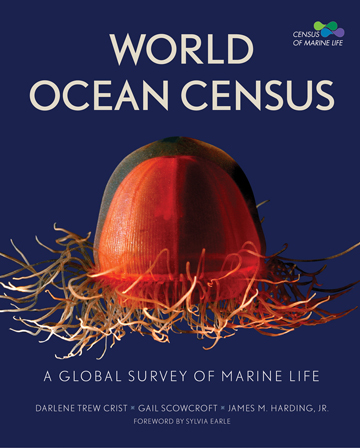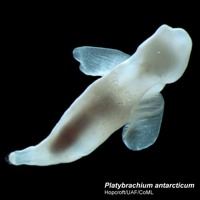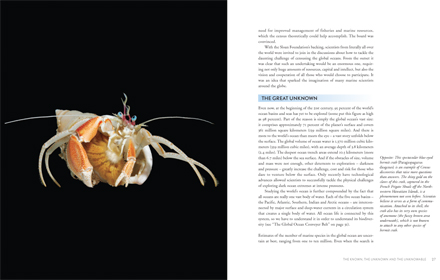Navigation
Book, World Ocean Census: A Global Survey of Marine Life, Highlights Findings of Ten-year Census of Marine Life 2000-2010
Started in the year 2000, Census of Marine Life (CoML) is an international science research program uniting thousands of researchers worldwide with the goal of assessing and explaining the diversity, distribution and abundance of marine life - past, present and future - by 2010.
Started in the year 2000, Census of Marine Life (CoML) is an international science research program uniting thousands of researchers worldwide with the goal of assessing and explaining the diversity, distribution and abundance of marine life - past, present and future - by 2010.
 |
| The Census includes the identification of 5,300 potentially new species. The deepwater jellyfish (Crossota norvegica) was photographed during a Census of Marine Life expedition to the deep Canada Basin in 2005. The photograph credit: Courtesy Kevin Raskoff/NOAA/Handout/Reuters/Corbis |
World Ocean Census: A Global Survey of Marine Life published by Firefly Books, October 15, 2009, is the only officially sanctioned book to bring the Census and its discoveries to the general reader.
Life on Earth sprang from the ocean and to a remarkable extent it still depends on this water body that covers 71 percent of our planet’s surface. Yet, very little of the ocean has been scientifically investigated. That is rapidly changing with the first-ever Census of Marine Life (CoML), a worldwide 10-year undertaking involving thousands of scientists from more than 80 nations.
World Ocean Census: A Global Survey of Marine Life written by a team of CoML’s scientists and educators, Darlene Trew Crist, Gail Scowcroft, James M. Harding, Jr., offers an unprecedented journey to the ocean depths, enabling readers to go behind-the-scenes of the study’s extraordinary findings and adventures.
Sylvia Earle, PhD, ambassador for the World’s Ocean and National Geographic Society Explorer-in-Residence wrote in her Forward to the book that “The importance of the Census is made urgent because at the same time that more is being learned about the diversity of life in the sea than during all preceding history, more is being lost….
“Some will treasure the World Ocean Census as a valuable reference, others as a place to find white-knuckle adventures. The images alone will cause many to re-evaluate their concepts of what astonishing forms are embraced within the bounds of what constitutes an eye, a heart, a body of living tissue. The underlying similarities shared by all living things – humans very much included – shine through, while maintaining wonder at the infinite capacity for diversity: from the broad divisions of life to the individual speckles and shapes that distinguish each sardine, salp and starfish from every other of its kind. Above all, the breakthroughs in knowledge gained, and awareness of the magnitude of what remains to be discovered, inspire hope that the greatest era of ocean exploration – and ocean care - will now begin.”
 |
| The ghost-like sea-angle Platybrachium antarcticum, flies through the deep Antarctic waters hunting the shelled pteropods (another type of snail) on which it feeds. This 3 cm long slug was photographed during the CEAMARC 2008 expedition aboard the Umitaka Maru to the Antarctic, part of a joint CAML/ArcOD/CMarZ effort. Credit: Russ Hopcroft, University of Alaska Fairbanks, Census of Marine Life. |
The Census of Marine Life set out to answer three basic questions:
What lived in the ocean?
What lives in the ocean?
What will live in the ocean?
These questions are of vital importance as scientists seek to understand the impact global warming and other factors—past and present—have had on the world’s oceans, and what that portends for the future.
World Ocean Census presents the answers to the three questions, as well as findings from the study’s additional goals:
- To assess and explain the diversity, distribution, and abundance of marine life
- To record how many of each species the ocean contains, where they live now, and where else they could live if/when habitats disappear
- To describe the life found in deep, previously unexplored areas that new technology is opening to scientists for the first time.
The Census of Marine Life, which will release its scientific report in 2010, is a project of extraordinary range and scope, as benefits its subject. Census researchers have journeyed to remote and dangerous places; charted the past using means as diverse as scientific reports, whaler’s logs, and seafood menus; and explored previously unexplored ecosystems. In the Antarctic, for example, climate change and melting ice shelves gave CoML researchers access to pristine portions of the ocean floor that had been sealed off for at least 5,000 years.
Among the study’s many important discoveries:
- Half of all the world’s food currently comes from the sea
- 90 percent of all large fish, such as tuna and swordfish, have disappeared from the oceans in the past 50 years
- The “great Pacific garbage patch,” a flotilla of trash that traps and kills marine life, is now nearly the size of Africa
- Half of the Caribbean coral reefs and one quarter of the world’s coral reefs overall have died due to pollution, destruction, and increasing water temperatures
- There is no part of the ocean that is not overfished. At the present rate, commercial fisheries could collapse by 2048.
- 1/2 the coral reefs in the Caribbean and 1/4 of the reefs around the world are now dead, devoid of oxygen and unable to support life (due to pollution, physical destruction and increasing ocean water temperatures)
- There are now more than 400 dead zones around the world (double the amount reported 2 years ago) that affect a total area of 245,000 square km (98,000 square miles)
- According to the Food & Agriculture Organization of the UN, an estimated 75% of major fisheries are fully exploited, overexploited or depleted
- "there is nowhere left in the ocean not overfished"
The Census includes the identification of 5,300 potentially new species.
 |
| Pages 26-27 from the book. This spectacular blue-eyed hermit crab (Paragiopagurus diogenes) is an example of Census discoveries that raise more questions than answers. The shiny gold on the claws of this crab, captured in the French Frigate Shoals off the Northwestern Hawaiian Islands, is a phenomenon not seen before. Scientists believe it serves as a form of communication. Attached to its shell, the crab also has its very own species of anemone (the fuzzy brown area underneath), which is not known to attach to any other species of hermit crab. Photograph Courtesy Susan Middleton |
In the book, readers will learn how the mystery of new life forms are revealed, how CoML research was planned and executed, how animals are tagged and tracked, and about the cutting-edge technologies that enabled this mammoth endeavor. Hundreds of breathtaking, full-color photographs plunge one deep into the ocean to see some of the millions of species — from the smallest microbes to the largest whales — that dwell beneath the waves.
The global ocean is truly Earth’s final frontier, its myriad secrets only now being revealed. World Ocean Census, and the study it brings to the public eye, are of inestimable importance to Earth’s future and, perhaps, man’s very survival.
The information in this article is from World Ocean Census: A Global Survey of Marine Life and from Firefly Books.
Book Notes:
Title: World Ocean Census: A Global Survey of Marine Life
Author: By Darlene Trew Crist, Gail Scowcroft, James M. Harding, Jr.;
Foreword By Sylvia Earle
Specs: 256 pages, 9 " x 11", color photographs throughout, glossary, further reading, index; $40.00 Plastic-laminated hardcover with jacket
ISBN: 1-55407-434-7 / 978-1-55407-434-1
Pub Date: October 15, 2009
Publisher: Firefly Books www.fireflybooks.com
Note:
Visit the Census of Marine Life for many features including videos.
Visit the Horizon International Magic Porthole Coral Reef Web site for book page previews: http://www.magicporthole.org/
There is a related article on the Horizon Solutions Site: Census of Marine Life Explorers Find Hundreds of Identical Species Thrive in Both Arctic and Antarctic
A video by the Census of Marine Life about why we need to monitor biodiversity in the oceans and how it can be done using existing technologies on a global scale. For more information visit http://www.coml.org.
Search
Latest articles
Agriculture
- World Water Week: Healthy ecosystems essential to human health: from coronavirus to malnutrition Online session Wednesday 24 August 17:00-18:20
- World Water Week: Healthy ecosystems essential to human health: from coronavirus to malnutrition Online session Wednesday 24 August 17:00-18:20
Air Pollution
- "Water and Sanitation-Related Diseases and the Changing Environment: Challenges, Interventions, and Preventive Measures" Volume 2 Is Now Available
- Global Innovation Exchange Co-Created by Horizon International, USAID, Bill and Melinda Gates Foundation and Others
Biodiversity
- World Water Week: Healthy ecosystems essential to human health: from coronavirus to malnutrition Online session Wednesday 24 August 17:00-18:20
- Mangrove Action Project Collaborates to Restore and Preserve Mangrove Ecosystems
Desertification
- World Water Week: Healthy ecosystems essential to human health: from coronavirus to malnutrition Online session Wednesday 24 August 17:00-18:20
- UN Food Systems Summit Receives Over 1,200 Ideas to Help Meet Sustainable Development Goals
Endangered Species
- Mangrove Action Project Collaborates to Restore and Preserve Mangrove Ecosystems
- Coral Research in Palau offers a “Glimmer of Hope”
Energy
- Global Innovation Exchange Co-Created by Horizon International, USAID, Bill and Melinda Gates Foundation and Others
- Wildlife Preservation in Southeast Nova Scotia
Exhibits
- Global Innovation Exchange Co-Created by Horizon International, USAID, Bill and Melinda Gates Foundation and Others
- Coral Reefs
Forests
- NASA Satellites Reveal Major Shifts in Global Freshwater Updated June 2020
- Global Innovation Exchange Co-Created by Horizon International, USAID, Bill and Melinda Gates Foundation and Others
Global Climate Change
- World Water Week: Healthy ecosystems essential to human health: from coronavirus to malnutrition Online session Wednesday 24 August 17:00-18:20
- Mangrove Action Project Collaborates to Restore and Preserve Mangrove Ecosystems
Global Health
- World Water Week: Healthy ecosystems essential to human health: from coronavirus to malnutrition Online session Wednesday 24 August 17:00-18:20
- More than 400 schoolgirls, family and teachers rescued from Afghanistan by small coalition
Industry
- "Water and Sanitation-Related Diseases and the Changing Environment: Challenges, Interventions, and Preventive Measures" Volume 2 Is Now Available
- Global Innovation Exchange Co-Created by Horizon International, USAID, Bill and Melinda Gates Foundation and Others
Natural Disaster Relief
- STOP ATTACKS ON HEALTH CARE IN UKRAINE
- Global Innovation Exchange Co-Created by Horizon International, USAID, Bill and Melinda Gates Foundation and Others
News and Special Reports
- World Water Week: Healthy ecosystems essential to human health: from coronavirus to malnutrition Online session Wednesday 24 August 17:00-18:20
- STOP ATTACKS ON HEALTH CARE IN UKRAINE
Oceans, Coral Reefs
- World Water Week: Healthy ecosystems essential to human health: from coronavirus to malnutrition Online session Wednesday 24 August 17:00-18:20
- Mangrove Action Project Collaborates to Restore and Preserve Mangrove Ecosystems
Pollution
- Zakaria Ouedraogo of Burkina Faso Produces Film “Nzoue Fiyen: Water Not Drinkable”
- "Water and Sanitation-Related Diseases and the Changing Environment: Challenges, Interventions, and Preventive Measures" Volume 2 Is Now Available
Population
- "Water and Sanitation-Related Diseases and the Changing Environment: Challenges, Interventions, and Preventive Measures" Volume 2 Is Now Available
- "Water and Sanitation-Related Diseases and the Changing Environment: Challenges, Interventions, and Preventive Measures" Volume 2 Is Now Available
Public Health
- Honouring the visionary behind India’s sanitation revolution
- Honouring the visionary behind India’s sanitation revolution
Rivers
- World Water Week: Healthy ecosystems essential to human health: from coronavirus to malnutrition Online session Wednesday 24 August 17:00-18:20
- Mangrove Action Project Collaborates to Restore and Preserve Mangrove Ecosystems
Sanitation
- Honouring the visionary behind India’s sanitation revolution
- Honouring the visionary behind India’s sanitation revolution
Toxic Chemicals
- "Water and Sanitation-Related Diseases and the Changing Environment: Challenges, Interventions, and Preventive Measures" Volume 2 Is Now Available
- Actions to Prevent Polluted Drinking Water in the United States
Transportation
- "Water and Sanitation-Related Diseases and the Changing Environment: Challenges, Interventions, and Preventive Measures" Volume 2 Is Now Available
- Urbanization Provides Opportunities for Transition to a Green Economy, Says New Report
Waste Management
- Honouring the visionary behind India’s sanitation revolution
- Honouring the visionary behind India’s sanitation revolution
Water
- Honouring the visionary behind India’s sanitation revolution
- Honouring the visionary behind India’s sanitation revolution
Water and Sanitation
- Honouring the visionary behind India’s sanitation revolution
- Honouring the visionary behind India’s sanitation revolution

